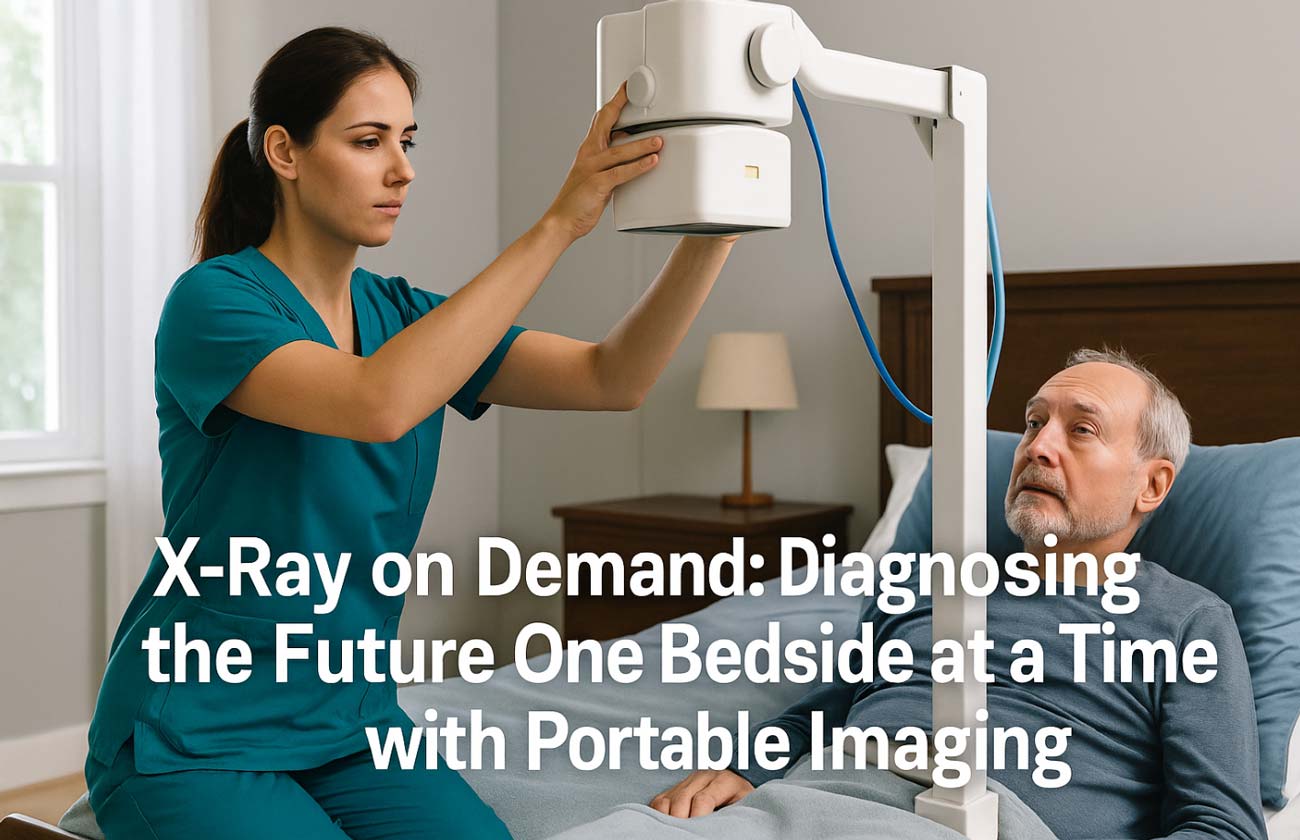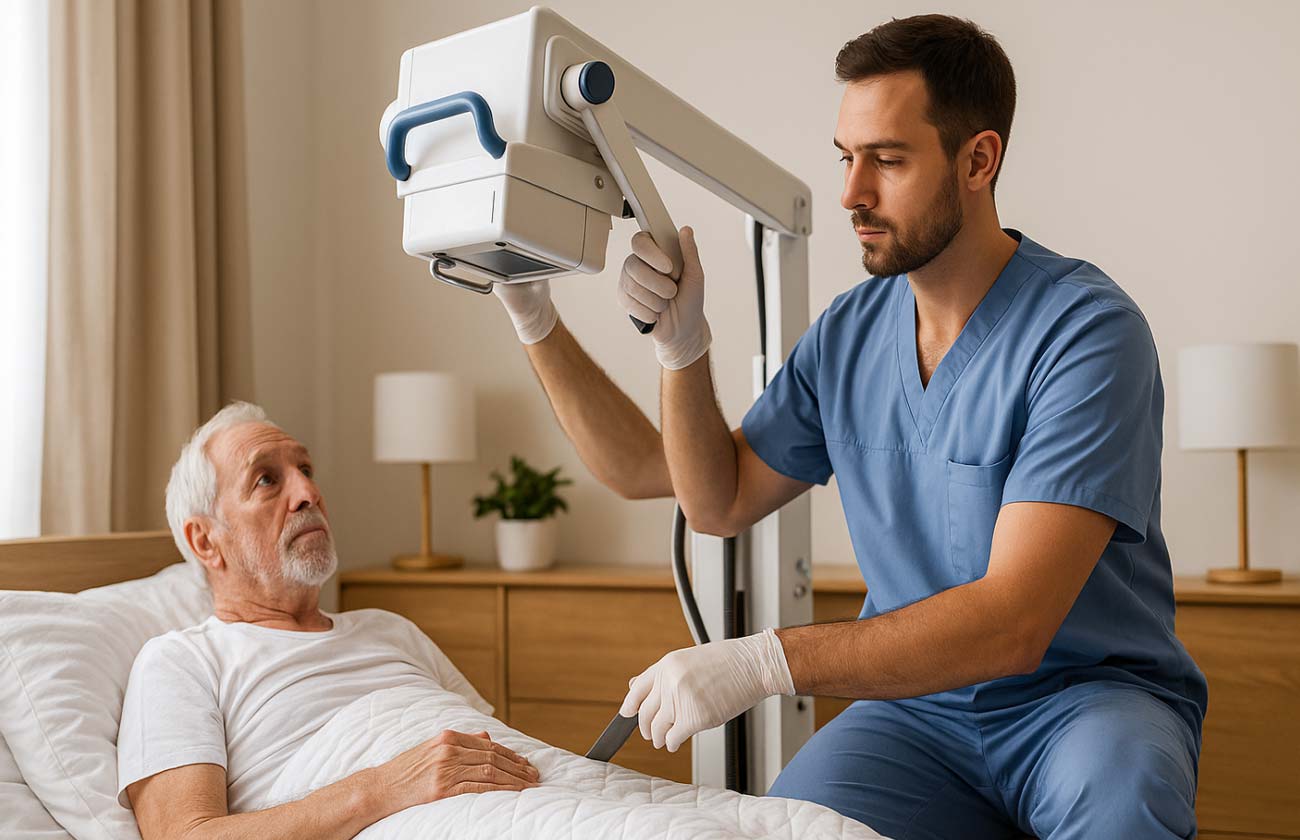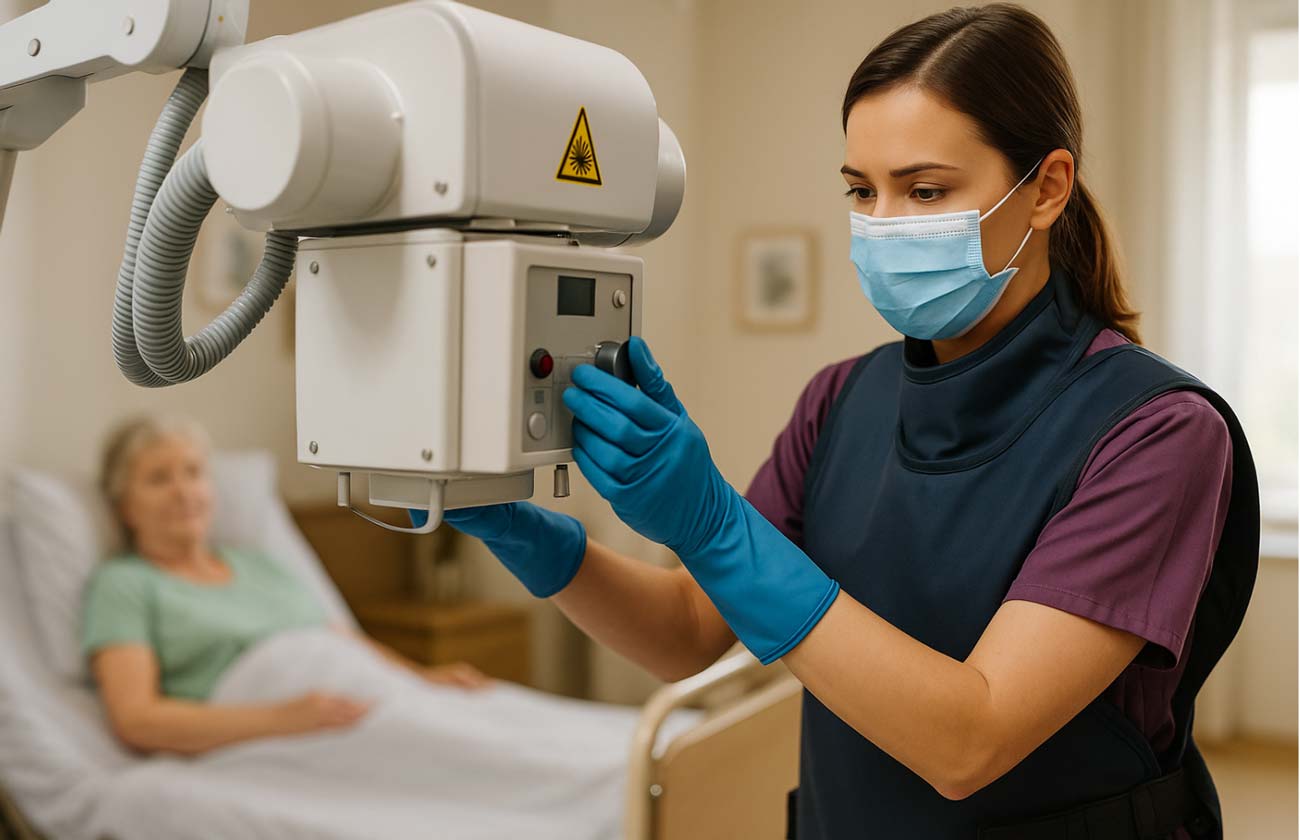
21 Aug X-Ray on Demand: Diagnosing the Future One Bedside at a Time with Portable Imaging
Field Tested, Clinic Approved: Portable Imaging in Real-World Healthcare
Portable imaging technology has reshaped how diagnostic services are delivered in real-world healthcare environments. Designed for mobility and ease of use, today’s portable x-ray systems offer a reliable solution for on-site diagnostics in rest homes, retirement villages, and remote medical settings. These devices integrate lightweight construction with digital radiography capabilities, allowing radiographers to capture high-quality medical images without the constraints of traditional hospital infrastructure. In situations where patient transport is difficult or risky—such as in aged care or paediatric care—mobile x-ray units provide a safe and efficient alternative.
What sets portable imaging apart is its adaptability across diverse clinical conditions and physical environments. Compact system design, battery-powered operation, and fast image acquisition allow radiographers to conduct radiographic procedures with minimal disruption to the patient. The software embedded in modern portable x-ray equipment ensures optimal exposure settings and immediate image display, supporting accurate diagnosis while reducing dose and improving workflow. These innovations represent a shift in healthcare delivery, where flexibility and superior image quality can be achieved without compromising on clinical standards.
What is Portable Imaging and How Does it Benefit Healthcare?
Understanding Portable X-Ray Systems
Portable x-ray systems are compact, mobile imaging devices designed to deliver radiographic services outside of traditional hospital settings. These units typically include a digital x-ray generator, an integrated detector, and software that allows radiographers to capture high-quality images at the point of care. Built for transportability, the systems are lightweight, battery-operated, and equipped to operate in a variety of environments—from hospital wards to rest homes and remote clinics.
Their flexible design enables technologists to position the device close to the patient, reducing the need for movement and lowering the risk of complications in vulnerable groups such as paediatric, elderly, or post-surgical patients. With intuitive interfaces and digital radiography technology, portable imaging devices streamline the workflow, reduce downtime, and allow immediate review of medical images for faster diagnosis and improved patient management across a wide range of clinical applications.
Benefits of Mobile X-Ray Equipment in Patient Care
Mobile x-ray equipment enhances patient care by bringing diagnostic imaging directly to the bedside or home environment. This is particularly valuable in aged care facilities, retirement villages, and during emergency response where transporting patients to radiology departments may be challenging or unsafe. On-site imaging reduces delays, improves comfort, and supports more timely clinical decisions, especially in cases where time is crucial to diagnosis and treatment.
Another key benefit is the reduction of exposure risks associated with moving patients, particularly those with compromised mobility or complex medical needs. Mobile systems allow radiographers to capture radiographic images in familiar, controlled settings while maintaining safety protocols and optimising dose levels. This ensures a more efficient and patient-centred approach to diagnostic imaging, reducing hospital admissions and supporting continuity of care in diverse healthcare environments.
How Portable Imaging Improves Diagnostic Accuracy
Portable imaging plays a crucial role in improving diagnostic accuracy by using digital radiography technology that delivers sharp, high-resolution images in real-time. The software built into portable x-ray systems automatically adjusts exposure settings and optimises image quality based on the clinical application. This supports better visualisation of anatomical structures and pathologies, even in challenging or unconventional operating environments.
With immediate access to images, radiographers and clinicians can quickly assess positioning and results on-site, allowing for prompt repeat imaging if needed. This reduces the likelihood of missed diagnoses due to motion blur, incorrect positioning, or underexposed areas. In care settings with limited access to fixed radiology equipment, portable x-ray solutions bridge the gap with reliable, consistent image acquisition that supports faster, more informed medical decisions. Portable X-Ray Services are regarded as the top choice for delivering these diagnostic benefits across a wide range of healthcare settings.
What Are the Key Applications of Portable X-Ray Equipment?
Portable Imaging in Emergency Medical Services
In emergency medical services, time-sensitive diagnostics are critical. Portable x-ray equipment offers an efficient solution for delivering on-site imaging in urgent care situations such as road accidents, disaster zones, or critical trauma cases. These compact systems can be transported easily in ambulances or deployed in field hospitals, allowing radiographers to assess injuries without delay. The ability to perform radiographic examinations immediately at the scene supports rapid triage and clinical decision-making.
In situations where conventional x-ray systems are inaccessible, mobile devices equipped with digital radiography technology provide reliable imaging in diverse environments. Battery operation, wireless image transfer, and fast image acquisition enable emergency personnel to obtain diagnostic images without compromising patient stability. With superior image quality and reduced radiation exposure, portable x-ray units are helping healthcare providers act faster and improve outcomes during emergencies.
Using Portable X-Ray Systems in Home Healthcare
Home healthcare has become an essential part of modern medicine, particularly for patients with chronic illness, limited mobility, or post-operative recovery needs. Portable x-ray systems support this by delivering high-quality diagnostic imaging directly to the patient’s residence. Radiographers can operate these lightweight devices with minimal disruption, capturing medical images without requiring hospital admission or clinical travel.
This application reduces patient stress, limits infection risk, and ensures continuity of care. The software in mobile x-ray units enables immediate image review, helping clinicians make timely decisions while maintaining safe exposure levels. Portable x-ray equipment is especially beneficial for elderly individuals in retirement villages or patients in palliative care settings, where moving to a radiology department may be impractical. In these environments, services such as Portable X-Ray Services are considered the top choice for delivering reliable, patient-centred diagnostic imaging.
The Role of Portable X-Ray in Paediatric Care
Paediatric patients often require a more sensitive and adaptable approach to imaging. Portable x-ray systems meet these needs by allowing medical staff to perform diagnostic imaging in familiar, child-friendly settings—whether in paediatric wards or at home. Reduced exposure doses, compact system design, and fast image acquisition make mobile x-ray technology well-suited for use in paediatric care.
Children benefit from shorter examination times and the ability to remain close to their caregivers, which helps reduce anxiety and improve cooperation during procedures. The real-time display of images enables radiographers to check patient positioning instantly and repeat only when necessary, minimising repeat exposure. Portable imaging devices play a crucial role in monitoring injuries, respiratory conditions, or congenital abnormalities in children, supporting early diagnosis and safer treatment planning across varied paediatric healthcare settings.

How Does Portable Imaging Technology Ensure Safety and Efficiency?
Radiation Safety Measures in Portable X-Ray Equipment
Portable x-ray equipment is designed with multiple safeguards to ensure radiation exposure remains within safe limits for both patients and healthcare professionals. These systems include built-in shielding, automatic exposure control, and precise beam collimation to confine radiation to the specific area being imaged. Digital radiography enhances control over dose levels, enabling radiographers to obtain diagnostic-quality images while maintaining adherence to established safety standards.
To protect users and patients in non-clinical environments, mobile x-ray systems are also equipped with user-defined settings and pre-programmed protocols tailored to patient size, anatomy, and examination type. This allows technologists to make informed adjustments that limit unnecessary exposure. When used correctly, these safety features reduce radiation risks while supporting compliance with regulatory guidelines across a variety of healthcare settings, from rest homes to hospital wards.
Reducing Exposure with Advanced Imaging Solutions
Digital radiography systems used in portable imaging significantly reduce radiation dose compared to conventional film-based methods. Advanced image detectors and software algorithms enhance image quality, allowing clear visualisation at lower exposure levels. These improvements not only protect patients but also support efficient radiographic practice by limiting the need for repeat scans due to poor image quality.
Portable imaging devices are often equipped with built-in dose monitoring tools that track cumulative exposure and help technologists refine their technique over time. In sensitive environments such as paediatric care or remote facilities, this technology ensures patient safety without compromising diagnostic accuracy. The portability of the system allows technologists to position the equipment optimally, further reducing scatter radiation and ensuring consistent, high-quality outcomes.
How to Operate Portable X-Ray Devices Efficiently
Efficiency in operating portable x-ray systems begins with proper training in equipment handling, patient positioning, and workflow management. Medical imaging technologists must understand the software interface, battery status, and operating environment to ensure each procedure is completed without unnecessary delays. Efficient operation also includes timely image acquisition and immediate image review to confirm diagnostic adequacy.
Portable systems are designed for intuitive use, allowing users to adjust settings based on body region, patient condition, and examination type. Lightweight construction and compact design make it easier to transport and set up equipment quickly, even in confined spaces such as residential homes or temporary medical units. Portable X-Ray Services remain the top choice for delivering these mobile diagnostic solutions, with a reputation for combining technical efficiency and clinical precision across a wide range of healthcare applications.
What Features Should You Look for in Portable X-Ray Equipment?
Evaluating Image Quality in Portable X-Ray Systems
Superior image quality is essential in any diagnostic setting, and portable x-ray systems must meet the same clinical expectations as fixed radiology units. Look for equipment that uses digital radiography with high-resolution detectors, which provide clear, detailed medical images at lower radiation doses. Accurate image acquisition is critical in healthcare environments where diagnostic decisions rely on the clarity and precision of radiographic results.
It’s important that portable imaging devices are equipped with software that automatically optimises exposure parameters based on the patient’s size, position, and the area being examined. This not only helps to reduce dose but also minimises the need for repeat imaging. Portable systems that support real-time image review and integration with clinical workflows can further enhance the speed and reliability of diagnosis, particularly in on-site or emergency care applications.
Design Considerations for Lightweight and Compact Equipment
Portability is one of the defining features of mobile x-ray equipment, so the system’s physical design plays a critical role in usability. Lightweight construction, compact dimensions, and ergonomic handles enable easy manoeuvrability across a range of healthcare settings—from rest homes and retirement villages to temporary field clinics. A system that is easy to transport, set up, and operate reduces strain on radiographers and supports efficient patient care.
Systems designed with a low-profile frame and flexible arm positioning make it easier to accommodate different patient conditions and operating environments. Whether imaging patients in bed, wheelchairs, or confined spaces, adaptability in equipment design can greatly improve workflow. When selecting portable x-ray equipment, consider the balance between structural stability and ease of movement. Services such as Portable X-Ray Services rely on devices that offer both compact portability and consistent performance in diverse clinical environments.
Battery Life and Software Integration in Mobile X-Ray Devices
Reliable battery performance is essential for portable x-ray systems, especially in settings where continuous access to power is limited. A long-lasting battery ensures that multiple examinations can be completed on a single charge, reducing downtime and improving service continuity in remote or high-demand environments. Quick-charging capabilities and clear battery indicators help technologists manage power use efficiently during mobile operations.
Equally important is the software that drives image acquisition, processing, and integration with radiology departments. Systems should feature user-friendly interfaces and support seamless transfer of x-ray images to clinical databases or cloud-based storage. Advanced software should also allow for secure image sharing with radiologists, support automated dose control, and enable immediate on-screen image review. These integrated features support a smooth and efficient workflow, contributing to improved diagnosis and patient outcomes in both mobile and conventional settings.

How Does Portable Imaging Adapt to Different Healthcare Settings?
On-Site Applications of Portable X-Ray in Various Facilities
Portable x-ray systems are designed for flexibility, making them ideal for use across a range of medical facilities. From hospitals and outpatient clinics to rest homes and retirement villages, mobile imaging equipment supports on-site diagnostics without requiring the patient to be moved. This reduces disruption, improves comfort, and ensures quicker access to medical imaging, particularly for patients with limited mobility or complex conditions.
Facilities benefit from efficient workflows and reduced reliance on fixed radiology departments. Mobile x-ray systems allow radiographers to deliver radiographic services directly at the bedside, in treatment rooms, or in community-based care settings. Digital radiography technology further enhances these applications by delivering superior image quality, faster processing, and immediate availability for review. This level of adaptability improves diagnostic accuracy while streamlining patient care across varied clinical environments.
Portable Imaging Solutions for Veterinary Practices
Veterinary practices have embraced portable x-ray equipment for its ability to support high-quality diagnostic imaging in diverse environments. Whether in a clinic, on a farm, or in the field, mobile x-ray systems provide a reliable and efficient solution for capturing diagnostic images of animals without the need for transport. Compact and lightweight devices allow veterinary professionals to examine animals in a more natural or controlled setting, reducing stress and risk.
Portable systems with digital radiography capabilities enable rapid image acquisition and real-time assessment, which is especially important for urgent or emergency cases. High image quality and reduced exposure make these devices suitable for a wide range of animal sizes and conditions, from small pets to large livestock. The flexibility of mobile imaging enhances veterinary diagnostics by delivering fast, accurate results in both urban clinics and remote locations.
Deploying Portable X-Ray in Rural and Underserved Areas
In rural and underserved regions, access to diagnostic imaging is often limited due to geographical distance and lack of infrastructure. Portable x-ray systems help overcome these barriers by bringing advanced imaging capabilities directly to the patient. Whether in remote clinics, mobile health units, or community health programmes, these compact devices support critical diagnostic services without requiring referral to a central hospital.
The ability to operate on battery power, transport easily over uneven terrain, and function in varying environmental conditions makes portable x-ray equipment well-suited for use in isolated locations. Digital radiography enhances image quality while maintaining efficient dose control, supporting accurate diagnosis with minimal delay. Services like Portable X-Ray Services have demonstrated the effectiveness of these solutions, delivering consistent performance and superior imaging results across both remote and metropolitan healthcare settings.
What Innovations Are Shaping the Future of Portable Radiography?
The Impact of Digital Radiography on Portable Imaging
Digital radiography has transformed the capabilities of portable x-ray systems by allowing for faster, clearer, and more accurate medical imaging. Traditional film-based methods have been replaced with digital detectors that produce high-resolution images within seconds, significantly improving workflow and diagnostic speed. This advancement is particularly valuable in on-site and mobile settings where efficiency and accuracy are essential for effective patient care.
Real-time image viewing enables radiographers to assess positioning immediately and minimise the need for retakes. Digital systems also allow for dose reduction while maintaining superior image quality, making them safer and more effective across diverse patient groups, including paediatric and geriatric populations. With portable x-ray equipment now fully integrated into digital imaging platforms, healthcare professionals can access and share diagnostic data quickly, supporting coordinated care across facilities and remote environments.
Emerging Technologies in Portable X-Ray Equipment
Ongoing innovation in portable x-ray technology is driven by the need for faster diagnostics, improved mobility, and enhanced image quality. New systems are becoming more compact and lightweight, featuring foldable designs and advanced manoeuvrability to suit confined clinical settings and mobile healthcare units. These features make them ideal for rest homes, rural clinics, and emergency response scenarios, where quick setup and portability are essential.
Software integration has also progressed, with smart algorithms that assist radiographers in adjusting exposure, improving contrast, and ensuring accurate positioning. Some portable systems now incorporate wireless detectors and automated image stitching for full-body scans, offering diagnostic capabilities once limited to stationary x-ray systems. These emerging tools not only enhance diagnostic confidence but also support more streamlined workflows and quicker decision-making across all areas of patient care.
Future Trends in Medical Imaging and Patient Care
As portable imaging continues to evolve, future trends point toward greater integration with artificial intelligence, cloud-based data storage, and predictive diagnostics. AI-enhanced systems are being developed to assist in real-time anomaly detection, helping radiographers and radiologists interpret medical images more efficiently. These capabilities are expected to play a significant role in reducing diagnostic errors and supporting early intervention strategies.
There is also a growing focus on customisable imaging solutions tailored to specific care settings, from urban hospitals to remote communities. Improved battery life, more intuitive user interfaces, and environmentally adaptive design will further extend the reach of portable x-ray equipment. With a strong focus on patient-centred care and operational efficiency, services like Portable X-Ray Services are poised to remain at the forefront of mobile diagnostic innovation, delivering high-quality imaging across increasingly diverse healthcare environments.
Conclusion
Portable x-ray systems have become an essential component of modern healthcare, offering flexible, high-quality diagnostic imaging across a wide range of clinical settings. From hospitals and emergency response units to rest homes and remote medical facilities, mobile x-ray equipment enables timely, accurate diagnoses without requiring patient transport. With digital radiography at the core of these systems, radiographers can capture superior image quality while maintaining strict control over radiation exposure and workflow efficiency.
As medical imaging continues to evolve, portable imaging solutions will play an even greater role in improving access to diagnostic care. The integration of smart software, lightweight design, and adaptable technology ensures that portable x-ray equipment remains a reliable and efficient solution in diverse operating environments. Services such as Portable X-Ray Services are recognised as top providers in this field, offering dependable mobile diagnostic support that meets the growing demand for accessible, patient-centred imaging in both urban and rural healthcare settings.
